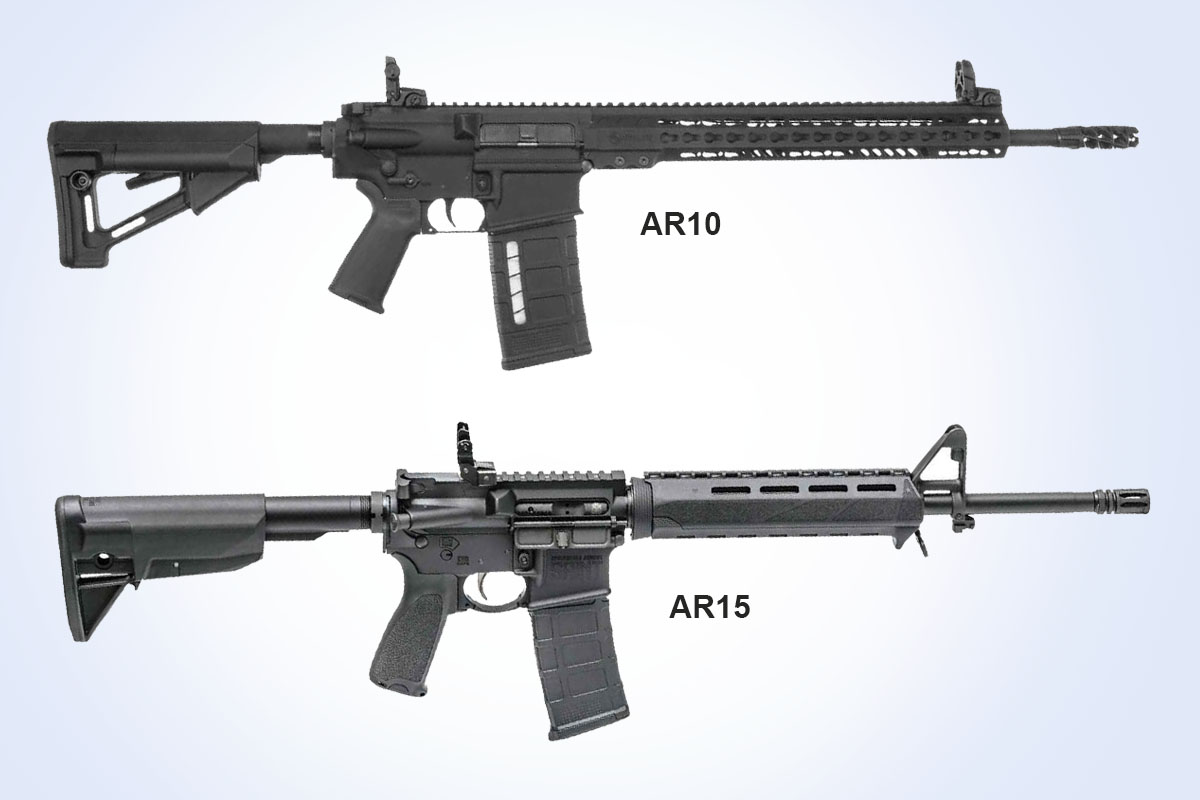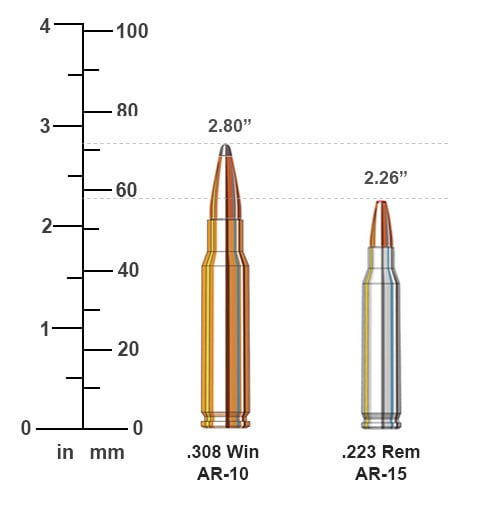AR-10 vs AR-15:
A Side by Side Comparison
By Trent Gander |

The AR-10 and AR-15 are a good example of two firearms that are named similarly but are different products. There are so many different variations of each that it can be confusing when trying to figure out which is better for you.
Today we are going to be doing a comparison of these related firearms to see how they are similar and we will go over some of the uses and benefits each has.
Comparing The AR-10 And The AR-15
The AR-10 preceded the AR-15 in development but both would go on to see military adoption around the world. The AR-15 would see the most recognition in the M16/M4 series of rifles used by the US military while the AR-10 saw use outside of the US.
The AR-10 would be revised later on into the SR-25 and AR-308. Most AR-10s on the market today are some variation of the AR-308 or SR-25 but for ease of reference we will just call them AR-10s. This allows us to easily compare the wider variety of firearms that AR-15s and AR-10s constitute.
Since the AR-15 is derived from the AR-10 we are going to start with the differences between these two platforms.
AR-10 and AR-15 Differences
While there are not a lot of differences between these two firearms, those that exist are significant. The caliber, bolt carrier, gas system and receivers are the major differences between the AR-10 and AR-15 with the buffer and spring of the gun being a secondary difference.
Caliber

The easiest difference to understand is related to caliber. The AR-10 and its variants are chambered in .308 Winchester/7.62x51 NATO. This .30 caliber round is popular with both hunters and militaries due to its range and effectiveness.
The AR-15 is chambered in 5.56x45 NATO/.223 Remington. This allowed the rifle to be lighter and more controllable. These factors would lead to the wider adoption of the AR-15 for military, self-defense, and sports shooting.
Bolt Carrier
Since the AR-10 and AR-15 use different ammunition their bolt carriers will be different. The AR-10 will have a larger, heavier bolt carrier since it is dealing with powerful loadings and a larger case. The AR-15 bolt is lighter and smaller by comparison.
Beyond their size and weight, both bolt carriers function identically.
Gas System
Both the AR-10 and AR-15 use a direct impingement gas system. This means some of the gas from the fired cartridge is channeled back into the bolt carrier in order to cycle the weapon. Since the bolt carriers are different sizes and weights, their gas systems are not interchangeable since the AR-10 needs larger gas ports and more gas than the AR-15.
Upper and Lower Receivers
This is one of the more confusing aspects of the differences between the AR-10 and AR-15. The bare upper and lower receivers of AR-15s and AR-10s are not interchangeable. This is because the lower receiver on an AR-10 needs to be longer in order to accept the .308/7.62 cartridge.
Additionally, some versions of the AR-10 do not have interchangeable upper receivers. Depending on the pattern of AR-10, the upper and lower receiver will be cut similarly to an AR-15 or they will have a diagonal cut that is not compatible. The major variations are AR-10/SR-25 and the LR-308/DPMS style. You need to be sure which receiver cut is used in order to have your upper and lower receiver work together since some AR-308s will use either.
Buffer and Spring
The buffer is another difference between the AR-10 and AR-15. The buffer helps slow down the reward travel of the bolt and can help reduce the perceived recoil of firing the gun. AR-10s require heavier buffers to slow the larger mass of the bolt and smooth out the recoil.
The spring used with the buffer needs to be strong enough to return the bolt forward at the end of the recoil cycle. While it is better to use a model specific spring, the spring can be swapped between the AR-15 and the AR-10
AR-10 and AR-15 Similarities/Interchangeable Parts
Since the AR-15 is the descendant of the AR-10 there are a lot of commonalities when it comes to parts compatibility. It is safe to say that anything that does not directly relate to the caliber or gas system is compatible between the AR-10 and AR-15.
Trigger Group
The trigger group is the primary example of parts compatibility between the AR-15 and AR-10. Trigger location and internals are the same between the two. The only reason the triggers should be different is if you have a specific role you want the rifle to serve that requires a change in the trigger. But you can put any AR style trigger group into either gun barring a handful of DPMS style rifles or hyper specific trigger groups.
Buffer Tube
The tube that holds the recoil buffer and spring can be used on either the AR-15 and the AR-10. Like it was mentioned earlier, the buffer itself is not interchangeable but the tube that is used for it can be. Depending on the tube length, spring weight, and buffer weight you might have to spend some time seeing which works reliably with your individual rifle.
Pistol Grips
While pistol grips are important for controlling the rifle comfortably, they are completely compatible with either rifle. You won’t need to find a specific AR-10 or AR-15 grip unless you are trying to replicate a historical piece.
Buttstocks
The buttstocks will be compatible. This is because they will be using the same interface between the buttstock and buffer tube.
Compatibility at a Glance
| Parts | AR-10 vs AR-15 |
|---|---|
| Caliber | Not Compatible |
| Bolt Carrier | Not Compatible |
| Gas System | Not Compatible |
| Upper/Lower Receiver | Not Compatible |
| Buffer and Spring | Semi-Compatible |
| Trigger Group | Compatible |
| Buffer Tube | Compatible |
| Pistol Grips | Compatible |
| Buttstocks | Compatible |
Benefits and Applications of AR-10s and AR-15s
While these rifles can be very similar they have different strengths and weaknesses. Local laws and what you intend to use the rifle for will determine which is the best option for you. Both rifles are highly modular with their modern incarnations and offer a lot of versatility. Let’s look at some of the benefits each offer and why you might choose one over the other.
AR-10 Applications and Benefits
The AR-10 is the older design, it is the less refined design of the two. The modern SR-25 and AR-308 would benefit from the advancements developed for the AR-15 but the AR-10 on the whole is less standardized than the AR-15.
Despite this, the AR-10 has a few advantages over the AR-15. The primary advantage is range. Since it is using .308/7.62 NATO it has a longer effective range than the AR-15 and with rounds that are less affected by wind. This makes it a better long-range semi-auto option.
The AR-10 allows you to have even faster follow up shots than a well-tuned bolt action rifle with similar accuracy. This is beneficial if you are hunting medium to large game or need a rifle that can be used both up close and far away.
With the wide variety of .308 loadings you can tailor your loads for whatever you are doing. Whether that is hunting hogs at close range or longer-range precision shooting. The only downside to this that the AR-10 requires more care in selecting upper and lower receivers, making it less “grab and go” than an AR-15
- Longer effective range
- Chambered in a common hunting caliber
- Wide variety of ammunition loadings
- Effective on medium to large game
- More effective against intermediate barriers
AR-15 Applications and Benefits
The AR-15 has been on the market long enough to experience roughly 60 years of refinement in both civilian and military circles. This means there are many more accessories and parts available for the AR-15 specifically.
The AR-15 is one of the most popular semi-automatic rifles on the market which means it is more accessible to the average person and easier to maintain than other options. Since it is chambered in 5.56 NATO it is easier to control across different shooters. This makes it better for self-defense, competition, and law enforcement use.
Depending on the loading, 5.56 is less likely to over penetrate interior walls and targets lessening the risk of unintentional shootings. Depending on your local laws, you can also use 5.56 for hunting although you may be restricted to medium or smaller game. Additionally, 5.56 is usually cheaper than .308 making it easier to afford live-fire practice with the AR-15.
Since the AR-15 has been so standardized over its lifetime, you can get a more affordable rifle that will work. It might not have as high a durability as a more expensive version, but it still will work for the average person.
- Affordable rifle and ammunition
- Easier to control and lighter than the AR-10
- Better for self-defense
- Lower risk of overpenetration
- Can be used on medium or smaller game depending on local laws